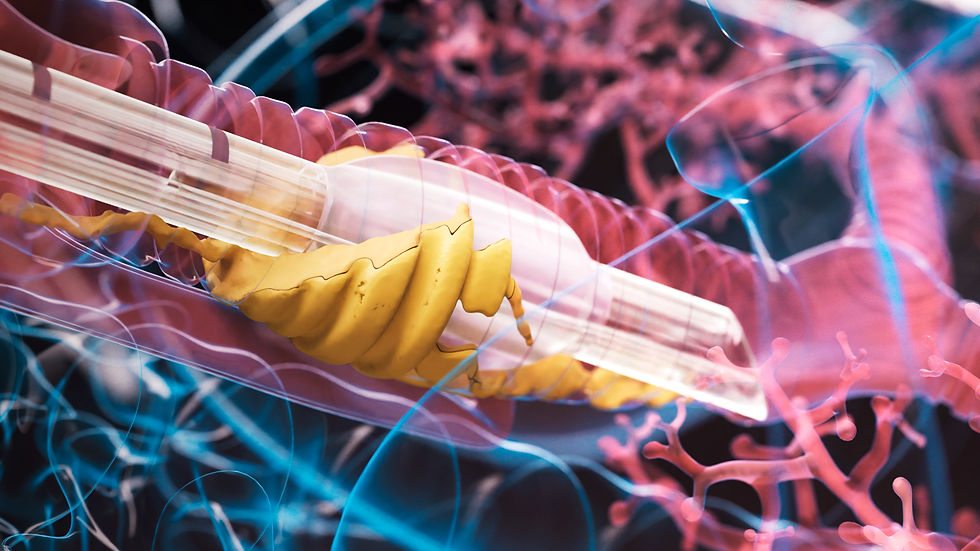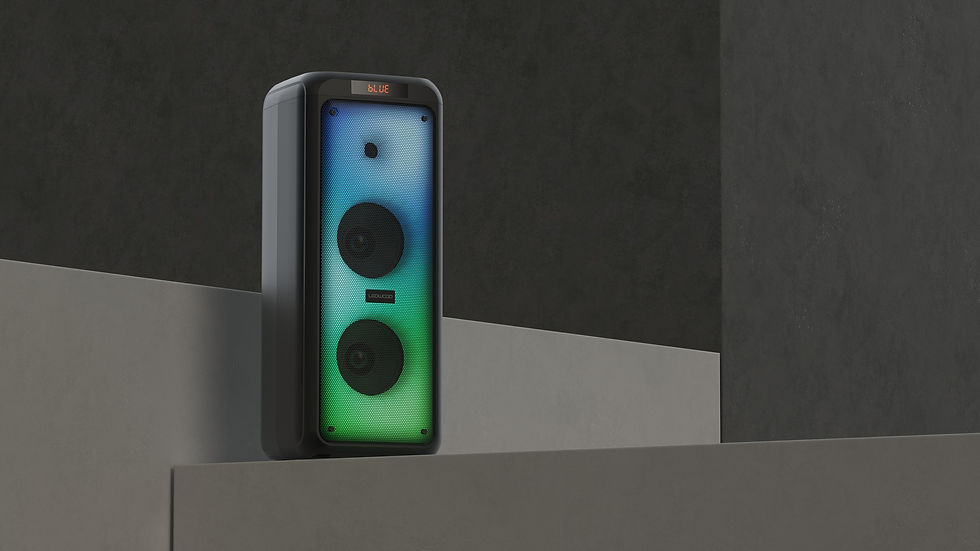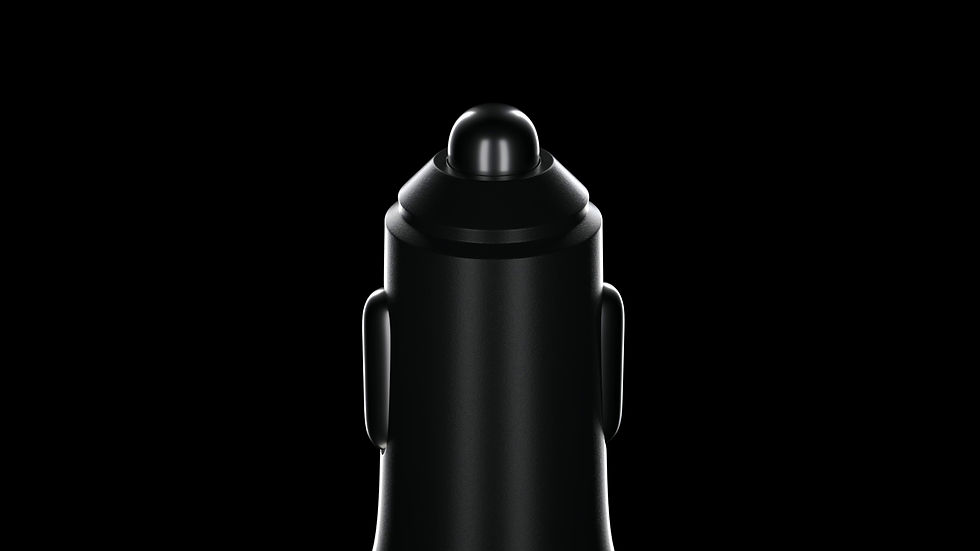Animation Facts: Interesting and Surprising Aspects of the Animation Industry
- Alexander Ulkin
- Dec 9, 2024
- 16 min read
Introduction
The animation industry has evolved from simple hand-drawn sketches to complex 3D renders and immersive CGI experiences, capturing the attention and imagination of audiences worldwide. Modern animation, particularly with 3D video animation, CGI rendering, and product rendering, is both an art and a science, powered by advanced Technology and creativity. From movies to corporate video production and marketing visuals, the animation field is a driving force in visual storytelling.
In this article, we'll explore fascinating facts about the animation industry, shedding light on surprising details that reveal its growth, technological advancements, and the skill required to create immersive animated content. We'll also delve into the importance of 3D animation for businesses and discuss how firms like Coast Team Studio can provide top-tier 3D animation and rendering services.
A Brief History of Animation: From Hand-drawn Art to 3D Video Animation
Early Animation Techniques and Groundbreaking Films
Animation, as we know it today, began with a few experimental techniques in the late 19th century, using flipbooks and primitive devices such as the zoetrope and praxinoscope. Early works like Gertie the Dinosaur (1914) and Walt Disney's Steamboat Willie (1928) are prime animation milestones that introduced audiences to moving illustrations. These hand-drawn films laid the groundwork for the animation techniques that continue to inspire animators today.
As Technology evolved, so did animation methods. In the 1990s, artists transitioned from hand-drawn frames to digital animation, streamlining the process and allowing for richer details and smoother transitions. This shift set the stage for the current era of 3D animation and CGI rendering, where sophisticated software enables a level of realism and precision that was previously unimaginable.
The Advent of 3D and CGI Rendering in Animation
The introduction of 3D animation marked a transformative era for the industry. Pixar's Toy Story (1995), the first full-length 3D animated movie, demonstrated the capabilities of CGI rendering and opened new doors for storytelling. Today, popular 3D animation software such as Autodesk Maya, Blender, Cinema 4D, and 3ds Max allow artists to create complex environments, lifelike characters, and intricate effects that are increasingly photorealistic.
CGI rendering now plays a significant role in films, TV shows, advertisements, and corporate video production, offering countless possibilities for animators and brands alike. With high-powered workstations and cloud-based rendering solutions, animators can create everything from product renderings to entire animated universes in detail that draws audiences in like never before.
Surprising Animation Facts That Showcase Industry Evolution
The Role of Physics in Animation
One fascinating aspect of animation is physics's role in creating believable scenes. Animators use a "physics-based animation" technique to replicate real-world movements, such as the bounce of a ball, the sway of a tree, or the way water flows. This technique makes animations look natural, helping audiences feel fully immersed in the animated world.
Specialized physics engines integrated into software like Houdini and Blender simulate complex interactions, such as gravitational pull and wind dynamics, that would otherwise take hours to animate manually. For example, animating hair, water, or fire requires a deep understanding of physics and animation to achieve realism, and the results are often breathtaking.
Rendering Times and Computational Power
Another surprising fact about animation is the computational power needed to render high-quality CGI. Rendering is a process where computers process all elements in a scene, including light, textures, and shadows, to create the final image. While a single frame can take seconds to minutes to render for a standard animation, high-quality 3D animations can take hours—or even days—per frame. For context, films like Avatar and Toy Story 4 require thousands of computers and enormous computational power.
Today, animators leverage cloud computing and GPU rendering farms to accelerate this process. These cloud-based solutions allow studios to speed up rendering without purchasing massive in-house hardware, making projects more cost-effective. However, complex 3D animations and intricate CGI-rendered images still require substantial rendering time, underscoring the technical challenges and resources in high-quality animation production.
Costs and Budgets in Corporate Video Production and 3D Animation
Animation and exceptionally high-quality 3D and CGI projects come with substantial costs. While independent animators can create simpler animations with modest budgets, professional-grade animations for film, product rendering, and corporate videos require a significant financial investment. Major studios often budget millions for animated projects, considering factors like rendering time, software costs, equipment, and the highly skilled labor needed.
Even in corporate video production, where animated explainer videos or product showcases are common, businesses allocate considerable budgets for quality animation. This investment is often worth it, as polished 3D video animation can enhance brand perception, improve product appeal, and even increase sales. Companies can maximize their investment by working with expert 3D animation agencies like Coast Team Studio, which produces high-quality CGI for diverse applications.
The Technology Behind 3D Video Animation: Tools and Software
Popular 3D and CGI Animation Software
Modern animation's success relies heavily on sophisticated 3D and CGI software, providing artists with the tools to create complex animations. Some industry-leading applications include Autodesk Maya, Blender, 3ds Max, and Houdini. Each software has strengths; for example, Maya's versatility makes it famous in film and video game production. Blender is highly regarded for its open-source nature and powerful rendering engine.
These applications allow animators to craft every element within a scene, from texturing surfaces and applying materials to fine-tuning lighting and effects. Each application also integrates with rendering engines like Arnold, Cycles, and Redshift, which help produce high-quality images essential in product rendering and 3D video animation.

Motion Capture Technology and its Impact on Realism
Motion capture (mocap) technology has revolutionized animation by efficiently creating realistic character movements. By attaching sensors to actors' bodies, animators can record absolute human motion and transfer it directly onto digital characters. Motion capture has been a game-changer for industries requiring realistic human movement, from movies and video games to corporate training videos and virtual reality applications.
Studios often use mocap to animate complex scenes, saving time and effort compared to traditional keyframe animation. Applications like MotionBuilder, a motion capture-specific program from Autodesk, streamline this process, ensuring smooth, lifelike animation in 3D projects. Motion capture adds a depth of authenticity that is otherwise challenging for CGI animation and requires high levels of realism, such as corporate video production or interactive product demonstrations.
Artificial Intelligence and Machine Learning in Animation
Artificial intelligence (AI) and machine learning (ML) have entered animation, particularly in areas that benefit from automation, such as crowd simulation, procedural generation, and even predictive rendering. AI algorithms now create natural-looking crowd movements in large-scale scenes or automatically generate complex environments. In addition, ML-enhanced render engines can adjust rendering parameters in real time, significantly speeding up the workflow.
AI's contribution to animation goes beyond efficiency and opens new creative possibilities. For example, deep learning algorithms can "train" software to recognize and recreate specific artistic styles, enabling animators to blend photorealism with stylized visuals seamlessly. With these capabilities, AI-driven animation tools are set to make waves in CGI rendering, product visualization, and various forms of 3D animation.
Different Types of Animation and Their Unique Characteristics
Traditional Animation: A Timeless Art Form
Traditional animation, often called hand-drawn or 2D animation, involves drawing individual frames by hand, with each frame slightly different from the previous one, to create the illusion of motion. While time-consuming, traditional animation remains an iconic and cherished style in the industry. Classics like Snow White and the Seven Dwarfs and The Lion King were crafted through conventional methods, with animators painstakingly drawing each frame.
Today, traditional animation is frequently used in various niches like animated TV series and indie films. Its nostalgic appeal and unique aesthetic make it a powerful tool for storytelling, even as the industry embraces CGI and 3D animation. Digital tools like Toon Boom Harmony allow animators to streamline traditional techniques, blending hand-drawn animation with digital effects for a modernized touch.
Stop-Motion Animation: Bringing Clay and Objects to Life
Stop-motion animation involves photographing objects or puppets frame by frame and adjusting them slightly for each frame to create movement. This technique, often associated with claymation, has been used in beloved films such as The Nightmare Before Christmas and Wallace & Gromit. Stop-motion animation is labor-intensive, requiring immense patience and precision, but the tactile quality of the resulting visuals is highly appealing and often challenging to replicate digitally.
In addition to films, stop-motion is popular in product rendering for advertisements, particularly when a whimsical or "homemade" quality is desired. Unlike CGI, stop-motion creates a sense of tangibility that resonates with viewers. Businesses can use stop-motion in corporate video production to create unique, memorable brand content that stands out in a digital-heavy landscape.
3D Animation: From Product Rendering to Immersive Films
3D animation is the most versatile and commonly used type of animation in modern media. From blockbuster films and TV shows to advertisements and video games, 3D animation is everywhere. Using 3D software, artists can create lifelike characters, realistic environments, and intricate effects, all contributing to engaging, immersive experiences. Notable 3D animated films like Toy Story and Frozen have cemented 3D as a staple in storytelling, beloved by audiences worldwide.
3D animation's applications go beyond entertainment. In product rendering and corporate marketing, 3D animation creates high-quality visuals that aid product demonstrations and brand storytelling. Rendered images of products can be showcased in 3D to highlight features in a way traditional photography can't, making it ideal for e-commerce and digital catalogs.
Animation Across Different Media: Film, Advertising, and Corporate Content
Animation in Advertising and Brand Storytelling
Animation has become a favored tool in advertising, offering brands an engaging way to communicate with audiences. From simple animations in social media ads to elaborate 3D video animations for TV and the web, animation helps brands tell their stories visually. Animated ads are not limited by real-world constraints, allowing for creative, fantastical elements that capture viewers' attention.
Incorporating CGI and 3D animation into advertising allows brands to differentiate themselves, showing products and services in an innovative light. For example, a company might use 3D animation to showcase a product's inner mechanics or to illustrate complex processes. As a visual medium, the animation is one of the most effective ways to build brand identity, especially when targeting a tech-savvy, visually oriented-audience.
Product Rendering for Marketing and eCommerce
Product rendering in 3D animation has revolutionized how products are displayed online. A rendered image can provide a detailed product view, showcasing every angle and feature with remarkable clarity. This technique is precious in the automotive, consumer electronics, and furniture industries, where buyers often want a clear, detailed view before purchasing.
Many brands now use CGI rendering instead of traditional product photography, especially for items in multiple colors or variations. By creating a high-quality 3D model, companies can produce endless variations without physical prototypes or photoshoots. Product rendering allows brands to deliver consistent, hyper-realistic images, providing a decisive advantage in eCommerce marketing.
Corporate Video Production and Explainer Videos
In the corporate world, animation is frequently used for explainer videos, training modules, and marketing content. Explainer videos, in particular, benefit from animation's ability to simplify complex ideas, making them accessible and engaging. For instance, a tech company might use 3D animation to demonstrate how its software works or to visualize data digestible.
Using CGI rendering and 3D animation in corporate videos enables companies to present their services innovatively. Animated videos can convey brand personality, educate viewers, and strengthen brand presence. Coast Team Studio, for example, offers customized 3D animation and CGI services tailored to corporate needs, helping companies present professional, visually appealing content that resonates with their audience.
CGI Rendering and Photorealism in 3D Animation
Creating Realistic Rendered Images with CGI
One of the most impressive aspects of CGI rendering is its ability to create photorealistic images nearly indistinguishable from real-life photography. Photorealistic CGI relies on precise lighting, texturing, and modeling to achieve this high level of realism, making it perfect for applications like product rendering and architectural visualization.
In 3D animation, artists meticulously design elements to look as lifelike as possible, from the textures of surfaces to the way light interacts with objects. A rendered image created using CGI can be tailored to highlight specific product details, emphasizing features or aesthetic qualities that may be hard to capture with a camera. This photorealism adds credibility and appeal, especially in product marketing and corporate branding.
The Role of Lighting, Texturing, and Shading in Realism
The magic of photorealism in CGI rendering largely hinges on lighting, texturing, and shading techniques. Lighting setups are crucial for achieving realistic results, as they can dramatically affect how objects look in a scene. Artists spend significant time adjusting light sources, whether it's to create soft natural light or dramatic shadows, as in film or product advertising.
Texturing and shading also contribute significantly to realism. Textures mimic real-life materials like metal, glass, or wood, giving objects a lifelike appearance. Shading algorithms calculate how light interacts with these textures, contributing to a sense of depth and volume. In tools like Substance Painter and V-Ray, artists can apply textures and manipulate shading properties, resulting in highly detailed, lifelike images suitable for 3D video animation, product rendering, and more.
Notable Achievements in CGI Rendering
The animation industry has seen incredible achievements in CGI rendering over the past few decades. From the photorealistic CGI animals in The Lion King (2019) to the groundbreaking water effects in Finding Nemo, CGI rendering continues to push the boundaries of realism. Achievements like these highlight the industry's commitment to refining CGI technology and advancing realism in digital media.
Even outside of entertainment, CGI has significant applications. Product rendering for marketing, virtual product presentations, and corporate training simulations benefit from CGI's ability to replicate real-life scenarios and objects. Companies that use CGI-rendered images in advertising and training can deliver experiences that feel more immersive and impactful, enhancing audience engagement and comprehension.

The Role of Animation in Virtual Reality and Augmented Reality
Animation in VR and AR Experiences
As Virtual Reality (VR) and Augmented Reality (AR) technologies develop, animation has become vital in creating these immersive experiences. VR and AR combine animation with interactive elements, allowing users to explore digital environments or view augmented aspects in the real world. These technologies have proven valuable for industries like real estate, gaming, and education, where users benefit from seeing objects and spaces in interactive 3D formats.
Incorporating 3D animation and CGI rendering into VR and AR offers endless possibilities. For instance, in product rendering, users can view a product 360 degrees, examining it from all angles. VR-based training modules use animated scenarios to teach new skills interactively, while AR allows companies to present products in real-world contexts. The ability to animate these elements opens new doors for brands offering memorable experiences.
Industry Examples: How Brands Use VR for Product Showcases
VR and AR have become powerful tools in product showcases, allowing brands to create immersive presentations that engage consumers. In automotive retail, for instance, brands like Audi and BMW use VR to let potential buyers explore car interiors and customization options. Similarly, makeup and furniture companies use AR to allow users to "try on" products virtually, a practice that has gained momentum in e-commerce.
These examples demonstrate animation's essential role in enhancing product showcases. By animating interactive elements, brands can create engaging, personalized experiences that traditional advertising can't achieve. The ability to "experience" a product before buying it significantly influences consumer purchasing decisions, adding substantial value for companies investing in VR and AR.

Future Possibilities for VR Animation in Corporate Video Production
VR and AR will likely become prominent in corporate video production and training, especially as the technology becomes more accessible. Animated VR scenarios can simulate corporate environments, training employees on everything from emergency procedures to customer interactions. By combining VR animation with real-world simulations, companies can offer immersive learning experiences that improve retention and engagement.
VR can simulate complex systems or demonstrate products at scale in product demonstrations. For industries like architecture, construction, and manufacturing, VR offers a way to visualize intricate details and make informed decisions during the design phase. The potential for animated VR in corporate settings is vast, allowing businesses to leverage 3D animation to enhance operations and customer satisfaction.

Key Facts on Animation Careers and Industry Demand
Growth in Demand for 3D Artists and Animators
The demand for skilled 3D artists and animators has grown dramatically as entertainment, advertising, gaming, and e-commerce increasingly rely on 3D animation. According to recent industry reports, the animation sector is expected to grow by around 10% annually, with 3D animation and CGI rendering representing significant portions of that growth. This surge in demand has also been fueled by advancements in augmented reality, virtual reality, and corporate video production, all of which depend on high-quality animated content.
Not only is the entertainment industry hiring, but fields like education, healthcare, and real estate are also looking for animators who can create immersive experiences. This increased demand presents many career opportunities for aspiring animators and 3D artists, with ample room for specialization in product rendering, 3D video animation, and CGI-based visual effects.
Skills Needed for a Career in 3D Animation and CGI
Building a career in 3D animation requires a diverse skill set, blending technical proficiency with creativity. Proficiency in 3D animation software—such as Autodesk Maya, Blender, and Cinema 4D—is essential. These tools are industry standards, and most professional studios expect animators to have at least a working knowledge of these applications. Specialized skills in texturing, rigging, and lighting are also valuable, as they contribute to the visual quality of animated scenes.
In addition to technical skills, animators must develop an eye for detail and an understanding of motion dynamics. Knowledge of physics and anatomy can help create realistic movement, whether animating human characters or other entities. Today’s animators increasingly use scripting languages like Python within software environments to streamline workflows, create procedural animations, or automate repetitive tasks. Artificial intelligence and machine learning skills will likely become integral as the industry progresses.
The Animation Pipeline: From Storyboarding to Final Render
Creating a high-quality 3D animation involves several stages, often called the animation pipeline. This process begins with storyboarding, where animators plan each scene’s visual sequence. Next, they develop a concept for the scene layout, building initial models and refining the environment. Once the primary components are established, the team moves to rigging, where character skeletons are constructed, allowing them to move realistically.
After rigging, animators focus on the animation stage, where characters and objects come to life. The scene then proceeds to texturing and lighting, where artists add materials and adjust the lighting to achieve the desired look. The final step, rendering, involves turning all elements into a cohesive, photorealistic image or video. This process can be time-consuming, particularly in high-resolution CGI rendering, but the result is an immersive experience that captivates audiences.
Animation and Environmental Impact: The Hidden Costs
Energy Consumption in CGI Rendering and 3D Animation Production
One of the lesser-known facts about animation, exceptionally high-quality CGI, is its environmental impact due to energy consumption. Rendering 3D animation requires substantial computational power, particularly when striving for photorealistic quality. Large animation studios often maintain extensive render farms—rows of high-powered servers that handle rendering tasks. These farms consume considerable electricity, contributing to a larger carbon footprint.
Many animation studios are adopting sustainable practices to mitigate this environmental cost. Cloud-based rendering services are one solution, allowing studios to access remote servers, which can optimize energy usage. Additionally, advancements in GPU-based rendering, which uses graphic processing units rather than traditional CPUs, make creating high-quality animations with less energy possible.
Sustainable Animation Practices
In response to growing awareness about environmental issues, the animation industry is beginning to explore sustainable practices. Many studios implement energy-efficient rendering techniques, such as progressive and real-time rendering, reducing time and energy consumption. Some companies also invest in renewable energy sources to power their render farms, aiming to reduce their carbon footprint without sacrificing visual quality.
Another approach is to use lighter animation techniques when feasible. For instance, a 2D or stylized 3D animation often requires less computational power than a hyper-realistic CGI scene, making it an attractive option for projects where photorealism isn’t essential. Studios adopting these practices contribute to a more sustainable future while still delivering captivating animated content.
Future Trends in Sustainable Animation and CGI
As the world becomes more eco-conscious, sustainable practices in animation are expected to become industry standards. Technologies like AI-driven rendering optimization are already helping studios reduce energy usage by automating parts of the rendering process. Real-time rendering, used frequently in gaming, also makes its way into other sectors, offering a more efficient alternative to traditional rendering methods.
Moreover, organizations like the Sustainable Animation Alliance are working to promote eco-friendly practices in the industry. These initiatives encourage animators to use renewable energy sources, recycle materials, and consider sustainability in every production stage. As sustainability becomes a priority, the future of animation will likely be marked by innovations that reduce environmental impact without compromising visual quality.
Animation Trends: What’s Next for the 3D and CGI Industry?
Hyper-Realistic Animation and Deepfake Technology
One of the most discussed trends in the animation industry is hyper-realistic animation, a style so detailed that it can be difficult to distinguish from reality. This approach is often used in character design for movies, video games, and simulations, adding depth to visual storytelling. Hyper-realistic CGI has allowed filmmakers to create lifelike animals, intricate landscapes, and realistic facial expressions, pushing the boundaries of visual fidelity.
However, this technology has raised ethical questions, particularly with the emergence of deepfake technology. Deepfake uses artificial intelligence to swap faces in videos, creating hyper-realistic but fabricated visuals. While deepfake technology has been used in movies and marketing, concerns over its misuse have led to discussions about the industry's ethical implications of hyper-realistic CGI.
Real-Time Rendering and Its Impacts on Production
Real-time rendering is another trend that’s transforming the animation industry. Unlike traditional rendering, which can take hours or days, real-time rendering allows animations to be created instantly, making it ideal for interactive applications like video games and virtual reality. Software like Unreal Engine and Unity are leading the charge in real-time rendering, providing platforms that allow animators to see changes as they work.
Real-time rendering streamlines workflows, especially in corporate video production, where quick turnaround times are often crucial. This technology allows animators to adjust, improving efficiency and lowering production costs. As real-time rendering improves, it’s likely to become a staple in animation, offering both speed and quality for various applications.
Procedural Animation and AI-Driven Effects
Procedural animation is a technique in which elements are created algorithmically rather than manually. This approach benefits large-scale animations like crowds, natural environments, or complex simulations. Using algorithms, animators can generate thousands of unique elements quickly and efficiently, making procedural animation ideal for creating vast, dynamic worlds in gaming and film.
AI-driven effects are also becoming increasingly popular, as artificial intelligence can automate complex tasks, from simulating physics to adjusting lighting dynamically. AI-enhanced tools like DeepMotion and NVIDIA Omniverse empower artists to generate sophisticated effects with minimal manual input. Procedural and AI-driven animation techniques are expected to play a significant role in the future of CGI, simplifying complex animations while maintaining high levels of detail.

Conclusion: Coast Team Studio’s Expertise in 3D Animation and CGI Rendering
As we’ve explored, the animation industry is an ever-evolving landscape filled with fascinating facts and groundbreaking advancements. From traditional animation techniques to cutting-edge 3D video animation, the possibilities in animation are endless. Technology continues to drive the industry forward, with developments in VR, AI, and real-time rendering opening up new opportunities for both animators and audiences.
For businesses leveraging these advancements, 3D animation provides a powerful communication tool, whether through product rendering, corporate video production, or CGI-rendered images. Coast Team Studio specializes in high-quality 3D animation, helping companies bring their visions to life with skill and precision. From concept to final render, our team of experts is equipped to deliver animated content that captivates and resonates with audiences, ensuring brands make a lasting impression.
FAQs
What are the main types of animation used today?
Animation techniques include traditional 2D animation, stop-motion, 3D animation, and CGI rendering. Each type offers unique characteristics and applications, from hand-drawn art to high-tech 3D animations.
How does CGI rendering differ from traditional animation?
CGI rendering involves creating scenes and characters digitally, focusing on realism, while traditional animation relies on hand-drawn frames. Due to its photorealistic capabilities, CGI is commonly used in films and product rendering.
What software is famous for creating 3D animations?
Leading software includes Autodesk Maya, Blender, Cinema 4D, and Houdini, all essential tools for 3D animators. These programs allow for detailed modeling, texturing, and CGI rendering.
What are some ways animation is used in corporate settings?
Animation in corporate video production includes explainer videos, product renderings, and virtual training modules. 3D animation is highly effective for illustrating complex ideas and enhancing brand engagement.
Why is rendering time so significant in CGI projects?
Due to the level of detail involved, rendering can be a time-intensive process. High-quality CGI rendering requires substantial computational power, and the final visual quality is often determined by the amount of time allocated to rendering.



Comments